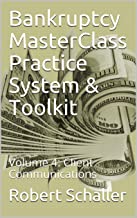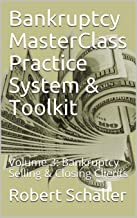Description
Bankruptcy Masterclass – Volume 4: Client Communications
Every attorney should read this book cover to cover before seeking his/her first client. Chapter 2 begins with a focus on the ethical requirements surrounding communications with prospective clients. For example, bankruptcy attorneys must be aware of the ethical rules regarding advertising and compensation imposed by their state bar. Plus, attorneys need to comply with the advertising and compensation limitations imposed by the U.S. Bankruptcy Code. These limitations are in addition to, and not an alternative to, the advertising and compensation limitations provided in the state rules of professional conduct. Congress imposed restrictions on any advertisement directed to the general public that indicates that the bankruptcy lawyer provides assistance with respect to credit defaults, mortgage foreclosures, eviction proceedings, excessive debt, debt collection pressure, or inability to pay any consumer debt.
Chapter 3 treats bankruptcy attorneys to a discussion on the importance of client communications to increase profitability and facilitate future client referrals. A bankruptcy attorney has an opportunity to imprint on each client’s psyche the notion that the attorney is a trusted advisor, competent lawyer, caring individual that the client can turn to for advice now and in the future when other legal or financial needs arise. What an opportunity to create a client for life! Chapter 3 presents 15 steps to great client care to enhance profitability through referrals.
Chapter 4 focuses on fact gathering during the initial client consultation. A standardized pre-printed intake form is an essential part of fact gathering. Fact gathering is one of the bankruptcy attorney’s chief goals when meeting with a prospective client for the first time. The intake form allows the attorney to better understand the prospect’s current financial situation and is a starting point for inquiries into the prospective client’s financial problems, goals, and possible solutions. A sample intake form is provided in Chapter 4.
Chapter 5 offers a detailed timeline of a typical Chapter 7 case. Bankruptcy attorneys must be prepared to explain the bankruptcy process to prospective clients. The difference between landing a prospective client and losing a prospective client may be the bankruptcy attorney’s ability to communicate the timeline for Chapter 7 cases. Prospective clients are anxious when they meet a bankruptcy attorney for the first time. The attorney must exude confidence and knowledge. Be ready for the questions about when certain bankruptcy events would occur. A solid familiarity with the bankruptcy timeline is essential. A day-by-day timeline is presented.
Chapter 6 discusses “non-engagement” letter agreements. Not every prospect will engage the law firm. To avoid malpractice claims, bankruptcy attorneys should utilize non-engagement letters that clearly communicate their decision NOT to accept an engagement. Three separate sample non-engagement letters are provided.
Chapter 7 highlights the need to tender bankruptcy disclosures to the prospective client by the bankruptcy attorney prior to a prospective client engaging the attorney. An attorney’s ethical responsibility is to provide a prospective client with sufficient information so that the prospective client can make an informed decision whether to engage the bankruptcy attorney, for what services, and at what cost. Best practices suggest that an attorney document the dissemination of key information. In addition to any ethical requirements, Congress also compelled bankruptcy attorneys to tender these certain disclosures when passing § 342(b) and § 527 of the Bankruptcy Code. Samples of each disclosure is provided.
Chapter 8 addresses written engagement letters, which are a must in every bankruptcy case. A written statement articulating the terms of the engagement reduces the possibility of misunderstanding and offers documentary protection if a disgruntled client claims the lawyer acted unethically. No oral representations. Lawyers are just inviting trouble when the inevitable disgruntled client complains that the scope of the relationship was broader than what the lawyer remembered it to be, or that the disgruntled client complains that the amount of compensation was lower than what the lawyer remembered it to be. Besides, Congress has imposed requirements upon bankruptcy lawyers relating to the engagement letter. First, a bankruptcy lawyer must execute a written contract with the client no “later than 5 business days after the first date on which” the bankruptcy lawyer provides services. A sample Chapter 7 engagement letter is featured.
Chapters 9 and 10 focus on the two-step fact-gathering process necessary to complete the petition, schedules, and statements required to be filed with the Clerk of the U.S. Bankruptcy Court. Fact gathering typically requires multiple communications with the client. As discussed in Chapter 9, each bankruptcy attorney should prepare a checklist of requested documents for clients to produce. The checklist should stress the importance of tendering all the documents on the list that are in the client’s possession and control. The checklist should identify a date by which the documents should be produced to the bankruptcy attorney. Chapter 10 focuses on the client questionnaire, which must be distinguished from the initial intake form completed at the time of the initial consultation. The initial intake form should be considered a brief summary of the prospective client’s financial position. The Chapter 10 client questionnaire is over 50 pages long and provides the details necessary to complete the petition, schedules, and statements. A sample client questionnaire is provided.
Chapters 11, 12, and 13 present sample communication letters relating to the client’s duties and responsibilities AFTER the bankruptcy case was filed. Chapter 11 communications involve tendering the petition, schedules, and statements to the client and urging the client to review the documents for accuracy. Chapter 12 focuses on the § 341 meeting of creditors. Chapter 13 addresses post-petition responsibilities relating to mortgage payments, lease payments, anticipated outcomes, reaffirmation agreements, redemption rights, the automatic stay, adequate assurance deposits to utility companies, and the instructional course concerning personal financial management.
Finally, Chapter 14 offers sample evaluation forms to be sent to each client to help improve the bankruptcy attorney’s practice and increase profitability. Separate evaluation forms relate to the initial consultation, the § 341 meeting of creditors, and the conclusion of the case.





Tax Law (verified owner) –
Communicating effectively with clients saves time and increases profitability. This book offers specific client letters for attorneys to copy and use on day one.